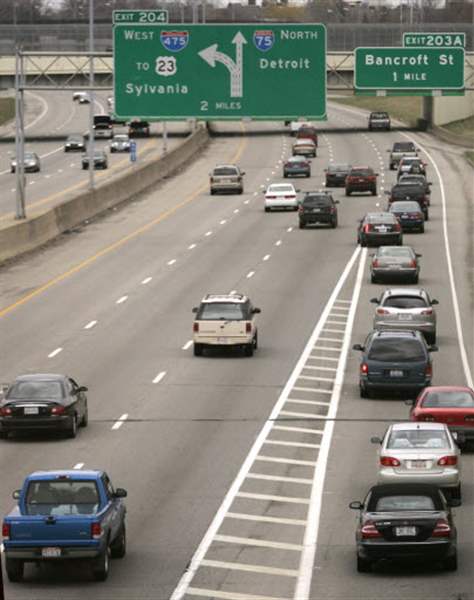
Limited 'job sprawl' found in Toledo area
4/6/2009
Rush-hour traffic heads north from downtown Toledo. Twenty-six percent of the metro area s jobs are within three miles of downtown, a study shows.

Rush-hour traffic heads north from downtown Toledo. Twenty-six percent of the metro area s jobs are within three miles of downtown, a study shows.
Despite the migration of businesses from Toledo to suburban sites such as Arrowhead Business Park over the past 30 years, eight of 10 jobs in the metropolitan area are within 10 miles of downtown, a new study concludes.
Metro Toledo has not avoided the "job sprawl" taking place in nearly every major metro area in the nation, but the shift of jobs away from the city core is less pronounced here than in many other places, researchers at the nonprofit Brookings Institution found.
"Toledo is more centralized than average," said Elizabeth Kneebone, study author and a senior research analyst at Brookings' metropolitan policy program.
Her study, which was released today, seeks to draw attention to the businesses' migration to the suburbs in a development that the authors say has important ramifications in areas including urban tax bases, transportation patterns, and energy consumption.
Just 21 percent of people in the nation's top 98 metro areas work within three miles of downtown, the study found.
And in many large cities, jobs are moving farther from city centers.
In metro Detroit, 77 percent of jobs are more than 10 miles from downtown.
In metro Chicago, the figure is 69 percent.

"Allowing jobs to shift away from city centers hurts economic productivity, creates unsustainable and energy-inefficient development, and limits access to underemployed workers," Robert Puentes, a senior fellow at Brookings, said in written comments.
The share of metro Toledo residents working within three miles of downtown decreased to 26 percent in 2006 from 27 percent 1998, the study reported.
Still, that concentration of jobs in the downtown and near-downtown area was higher than in all other Ohio cities studied.
In Cleveland, just 16 percent of jobs were three miles or less from downtown.
In Cincinnati and Youngstown, the figure was 17 percent; in Columbus, 19 percent; in Dayton, 24 percent, and in Akron, 25 percent.
The study used 1998 and 2006 job figures estimated by the U.S. Census Bureau's Business Patterns reports.
Helping boost Toledo's near-downtown total is Chrysler LLC's Jeep assembly plant, said Sue Wuest, assistant director of the Urban Affairs Center at the University of Toledo.
The factory complex, built in the late 1990s and expanded in this decade, helped preserve and attract thousands of jobs in Toledo's near-north side.
Excluding the Jeep plant and looking only at Toledo's downtown and areas immediately surrounding it, The Blade found last year that employment declined by more than 2,200 between 2000 and 2005.
Ms. Wuest said she doubts that trends in the metro Toledo labor market are much different than in other parts of the nation.
A hopeful development, she said, is solar-panel research at UT and the presence in northwest Ohio of firms involved in solar-panel production.
"If we could make more of those projects happen closer to the core of the city, we would be on a good path," she added.
In another finding of the study, Brookings researchers said the number of jobs within 35 miles of downtown Toledo increased by 3,755 between 1998 and 2006 to 282,840.
Those findings are consistent with federal employment statistics showing that metro Toledo's labor market continued to grow through the onset of the current U.S. recession in December, 2007.
Steve Weathers, president of Toledo's Regional Growth Partnership, agreed that job sprawl can create problems including traffic congestion, increased pollution from automobile exhaust, and nonproductive time spent traveling to and from work.
But he said it is less of an issue in smaller, relatively concentrated population centers like metro Toledo. "It's more of a concern in larger metro areas that get so sprawled out that people are traveling 1 1/2 to 2 hours to get to a job."
Contact Gary Pakulski at:
gpakulski@theblade.com
or 419-724-6082.